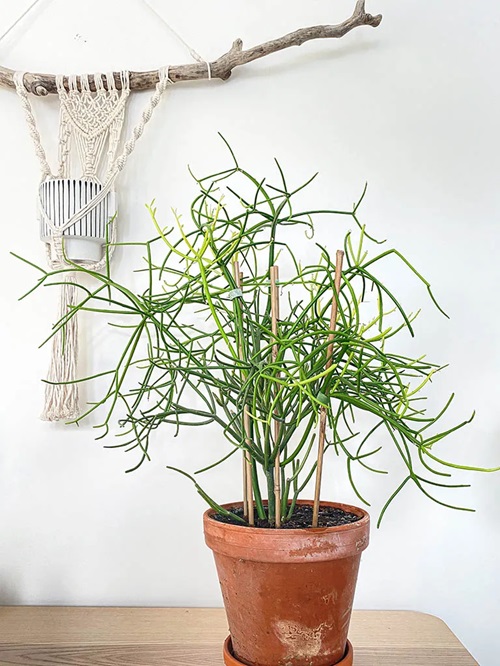Learn How to Grow Pencil Cactus with this post and add this succulent shrub with elongated stems like pencil to your indoor garden.
If you are looking for a plant that thrives on neglect and makes a bold impression, then Euphorbia Tirucalli is perfect for you! But before you learn more about How to Grow Pencil Cactus, it’s important to note that the sap of this houseplant is very toxic if ingested. So, if you have kids in your home or dogs or cats that are carefree and nibble everything, it’s better to postpone growing it or keeping it out of their reach.
Pencil Cactus Information
It must have originated in desert parts of Africa or South Asia, which is why the pencil cactus is succulent and has a tremendous ability to tolerate drought and negligence! It has slender and thin stems that give it the appearance of pencils grouped in clusters! One of the characteristics that the plant is known for is its fatal milky sap, which is hard to take off.
The plant also grows tiny flowers during late spring and early summer and becomes fiery red or orangish when it feels stressed by cold or hot temperatures in winter or summer. This is why it is also known as the Firestick Plant!
Propagating Pencil Cactus
The pencil cactus is extremely easy to propagate from cuttings. However, its sap is toxic, so always wear gloves when handling it.
Snip off 4-6 inches long cutting from a healthy plant. Let the cutting dry out for 3-6 days and form a callus. Once done, plant it in a pot in any soil or cacti mix. Keep it in a bright location where it gets indirect light.
The cutting will form roots in 3-4 weeks.
Growing Requirements of Pencil Cactus
Location
The Pencil Cactus loves full sunlight, which means the more you give it, the more colorful it will become. Surprisingly, it can also grow in low light.
You can easily grow it in rooms with indirect light. A window with southern or western exposure is recommended if you don’t want to lose its color.
While direct sun exposure will help the plant get that fiery red edge on the tiny foliage and stems, low light will make it green.
Soil
The plant does best in any soil type, so you don’t have to worry about this much. However, it is most suitable for a well-drained potting mix that can remain dry.
Watering
You don’t have to bother much about the plant’s watering needs as it grows in dry soil. Watering it once in 10-20 days should be fine. If you have kept the plant in full sun, then keep an eye on the topsoil and water whenever it feels dry to the touch.
Temperature
The plant performs well in warmer climates and does best in a temperature range between 65-75°F or 18-25°C. Make sure the temperature does not drop below 50°F or 10°C for a long time.
Pencil Cactus Plant Care
Fertilizer
The plant takes care of itself, so you don’t have to worry much about feeding it regularly. In fact, fertilizing too much can kill its growth and development.
If you want to boost its growth, use a balanced liquid fertilizer diluted to half its strength once every 8-10 weeks. Refer to the label for instructions.
Also, do not feed the plant in winter in USDA Zones 9 and below, as it does not grow actively at this time in cold climates.
Pruning
Prune the plant to keep it in shape, as it can grow wild in all directions. Snipping it now and then will keep the growth in check. Also, dead and damaged foliage must be removed from time to time.
Note: When pruning the plant, always wear gloves, as its milky sap can cause severe skin irritation. Also, do not forget to wash your hands, as if the sap gets into your eyes, it can cause temporary blindness.
Pests and Diseases
Spider mites commonly attack pencil cactus. Though these pests are inconspicuous, they look like tiny flecks of red, yellow, or green on the plants. Knock them off using a strong water jet or an insecticidal soap solution.
Toxicity
According to the American Society for the Prevention of Cruelty to Animals, the plant is toxic to pets, causing severe irritation to the mouth and stomach. It can cause serious side effects if swallowed and can cause temporary blindness and vision issues if it gets into the eyes.
Keep it out of the reach of children and pets.
How to Make Pencil Cactus Colorful
Keep the plant in a root-bound state, water less than required, and ensure it gets plenty of direct sunlight. Also, exposure to cold and hot temperatures will make it blush quickly. All these measures will make it colorful! The best way to make it take the glorious yellow, red, and orange hue is to neglect it.













